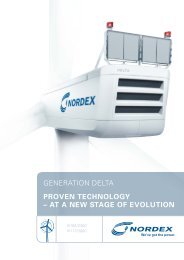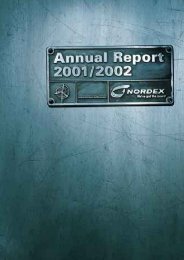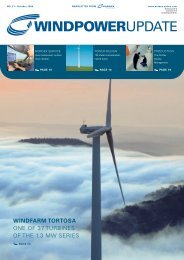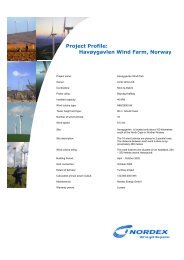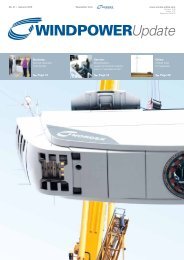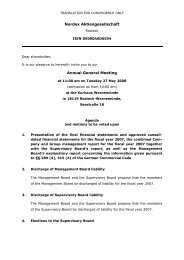OFFERING MEMORANDUM Global Offering of up to ... - Nordex
OFFERING MEMORANDUM Global Offering of up to ... - Nordex
OFFERING MEMORANDUM Global Offering of up to ... - Nordex
Create successful ePaper yourself
Turn your PDF publications into a flip-book with our unique Google optimized e-Paper software.
The calculation <strong>of</strong> imputed taxes, <strong>to</strong>o, was based on future tax rates, cf. Note (1).<br />
Inven<strong>to</strong>ries include raw materials and s<strong>up</strong>plies (operating s<strong>to</strong>res), as well as work in process (goods/<br />
services). In conformity with IAS 2, raw materials and s<strong>up</strong>plies were stated at purchase cost. Allowances<br />
were charged for slow-moving items, varying according <strong>to</strong> age and product, and for inven<strong>to</strong>ries whose<br />
fair market prices were below their carrying values. Work in process for which no cus<strong>to</strong>mer contract<br />
existed and <strong>to</strong> which IAS 11 did hence not apply were valued at production cost pursuant <strong>to</strong> IAS 2. The<br />
production cost components <strong>to</strong> be included according <strong>to</strong> IAS 2 were recognized wherever the costs<br />
were reliably measurable. Borrowing costs were not included in production cost. Provided and <strong>to</strong> the<br />
extent that in specific cases production cost (including any overheads yet <strong>to</strong> be incurred) was<br />
foreseeable <strong>to</strong> outweigh expected net revenues, the underlying asset was written down <strong>to</strong> its lower net<br />
realizable value. Moreover, prepayments made on inven<strong>to</strong>ries were stated, and those received on<br />
account <strong>of</strong> inven<strong>to</strong>ries were deducted, at their face values.<br />
Future receivables under long-term construction contracts (i.e., costs and estimated earnings in excess<br />
<strong>of</strong> billings) were accounted for according <strong>to</strong> their percentage <strong>of</strong> completion (‘‘PoC’’) according <strong>to</strong> IAS 11<br />
where based on a specific cus<strong>to</strong>mer contract and contract costs were reliably allocable. Prorated<br />
earnings were realized according <strong>to</strong> the PoC where the latter as well as <strong>to</strong>tal contract costs and<br />
revenues were reliably determinable in conformity with IAS 11. The PoC was determined by using the<br />
cost-<strong>to</strong>-cost method, i.e., by relating the costs incurred <strong>to</strong> the estimated <strong>to</strong>tal contract costs. Applying<br />
this PoC <strong>to</strong> revenues, the resulting portion <strong>of</strong> <strong>to</strong>tal contract revenues was realized accordingly. Contract<br />
costs comprise all direct costs allocable <strong>to</strong> the contract, as well as all indirect costs separately billable <strong>to</strong><br />
the cus<strong>to</strong>mer (as defined in IAS 11) and if reliably measurable. Costs <strong>of</strong> debt were expensed. If the<br />
contract revenues were not determinable with reasonable reliability, valuation was based on contract<br />
costs according <strong>to</strong> IAS 11.<br />
When determining contract costs and revenues, any new insights with respect <strong>to</strong> the periods under<br />
review at the time the (combined) pro forma consolidated financial statements were prepared were<br />
duly taken in<strong>to</strong> account. Losses incurred for specific contracts and ascertained subsequently were also<br />
accounted for.<br />
In the balance sheet, this item was disclosed as ‘‘future receivables under long-term construction<br />
contracts’’ and, in the income statement, under net sales. Where specific contracts produced a loss on<br />
balance, such loss was shown separately on the liabilities side as ‘‘future payables under long-term<br />
construction contracts.’’ In the income statement, such losses were disclosed as cost <strong>of</strong> materials.<br />
Prepayments received on contracts were <strong>of</strong>fset against ‘‘future receivables under l/t construction<br />
contracts’’ unless the <strong>to</strong>tal turned in<strong>to</strong> a negative balance (i.e., a payable).<br />
Trade receivables and sundry current assets were recognized at par, duly allowing for any and all<br />
foreseeable risks. General allowances for doubtful accounts were eliminated when restating the<br />
separate financial accounts <strong>to</strong> conform <strong>to</strong> IAS.<br />
Cash & cash equivalents are valued at par.<br />
In accordance with IAS 37, the sundry accruals provide for all uncertain obligations <strong>to</strong> third parties.<br />
Provisions were made wherever current legal or economic commitments existed that resulted from past<br />
events and whose settlement was probable <strong>to</strong> entail an outflow <strong>of</strong> resources embodying economic<br />
benefits. Accruals were measured on the basis <strong>of</strong> best estimates. Discounting was waived for lack <strong>of</strong><br />
materiality.<br />
Liabilities were recognized at the amounts repayable.<br />
Expenses and income <strong>of</strong> the periods were recognized when realized, regardless <strong>of</strong> the payment date.<br />
Revenues were recognized when the agreed product or service was provided or when realized early as<br />
required by the PoC method under IAS 11. Period-related income and expenses were only accounted<br />
for <strong>to</strong> the extent allocable <strong>to</strong> the period.<br />
F-15





